8 min. reading
Front Yard Desert Landscape Ideas – Create a Stunning and Low-Maintenance Outdoor Space
Juliy Cherevko
CEO paintit.ai
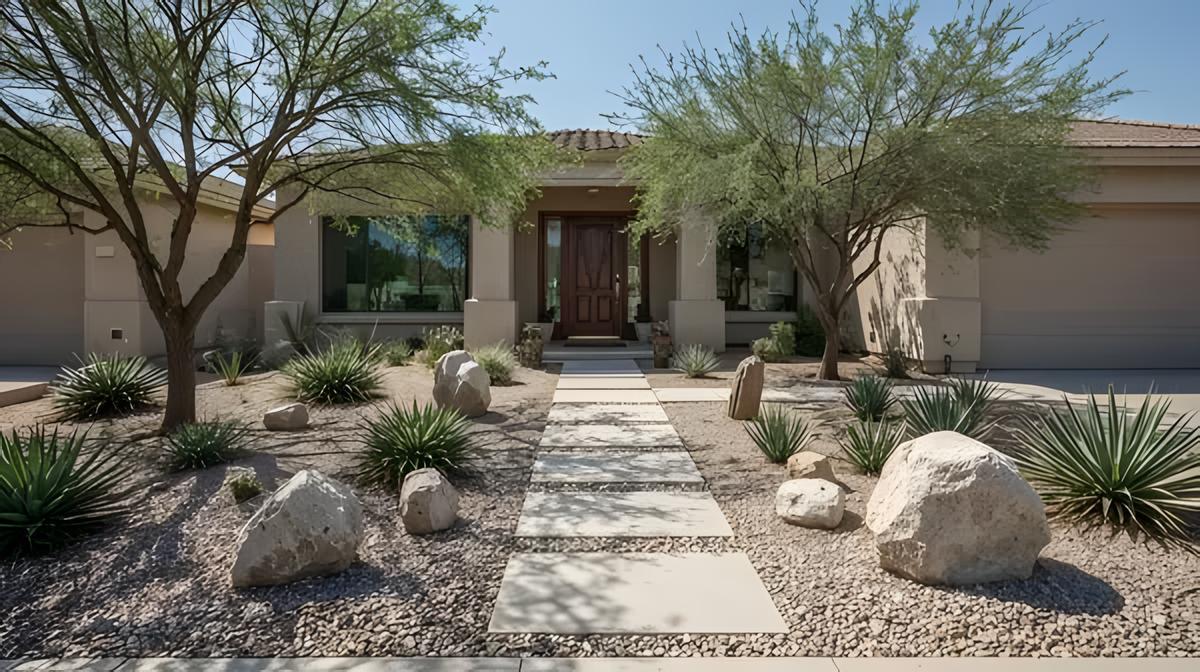
Page Contents:
- 1. What is a Desert Landscape?
- 2. Key Considerations Before Starting Your Front Yard Desert Landscaping
- 3. Best Front Yard Desert Landscaping Ideas
- 4. Front Yard Desert Landscaping Ideas on a Budget
- 5. Essential Elements of a Desert Landscape Front Yard
- 6. Front Yard Desert Landscaping Maintenance Tips
- 7. How Paintit.ai Can Help You Design a Perfect Desert Front Yard
- 8. Conclusion
- 9. Frequently Asked Questions
Creating a stunning and low-maintenance front yard desert landscape is not only visually appealing but also eco-friendly. Desert landscaping is water-conserving, maintenance-reducing, and curb appeal-enhancing. Whether you are re-designing a small plot or re-landscaping a large one, this article will guide you through the creation of the perfect desert front yard.
What is a Desert Landscape?
Desert landscaping is a style of garden and landscape design best suited for arid and semiarid climates. It revolves around the use of drought-resistant plants-such as succulents, cacti, agave, yucca, and grasses native to the area-that can thrive under minimal watering. Rather than installing the traditional turf lawn or thirsty plants, desert landscaping utilizes hardscape material like gravel, decomposed granite, big rocks, and sand to create texture, shape, and beauty. This design not only saves water but also minimizes maintenance and is in harmony with sustainable, environmentally friendly living in warm climates.
Key Considerations Before Starting Your Front Yard Desert Landscaping
Before diving into design specifics, it's important to understand the foundational elements that influence a successful desert front yard. A well-executed desert landscape balances beauty, function, and sustainability. From choosing climate-appropriate plants to ensuring your layout supports water conservation, these early considerations will shape the long-term success of your outdoor space.
Climate & Sun Exposure
Measure the sunlight in your front yard during daytime. Most desert plants, such as cacti and agave, enjoy full sun and need at least 6-8 hours of direct sunlight per day. Others, such as aloe vera or desert spoon, will do well under partial shade in hot weather. Marking sun and shade zones will allow for effective placement of plants, preventing sunburn or stunted growth and encouraging your landscape to last long.
Soil Preparation & Drainage
Effective desert gardening relies upon effective drainage. Root rot may be incredibly rapid in saturated soil, even in plants adapted to drought. Conduct your preplant soil test and correct with coarse sand, crushed granite, or perlite to permit penetration of air. Incorporating a gravel sub-base beneath the topsoil also improves permeability. Build raised beds or grade the yard slightly to intercept runoff and direct it away from roots and water-collecting areas.
Budget Planning for a Desert Scape Front Yard
Start with a budget firmly set for up-front and regular costs-gravel, edging, mulch, plants, lights, irrigation. Add installation costs when hiring professionals, and then determine a list of items in priority order according to what is most essential and important. On the budget-friendly path, add recycled hardscape materials, locally purchased gravel, and pruned plant material from neighbors or public gardens. Solar lights and cheap drip irrigation can yield a useful dividend, too.
Best Front Yard Desert Landscaping Ideas
Your front yard is your house's first impression-and a desert landscape can make it linger. By combining drought-tolerant plants, artistic hardscaping, and strategic layouts, you can transform an ordinary yard into a serene, low-maintenance masterpiece. Clean modern lines or organic, weathered ease-there's a desert landscape idea for every style and price.
1. Modern Minimalist Desert Front Yard
Embrace simplicity through clean lines, symmetrical planting, and muted colors that fit modern design ideals. Geometrically set concrete pavers bring form, whereas gravel offers texture and creates drainage. Strategically mixed sculptural cacti like golden barrel, saguaro, or euphorbia brings architectural texture. Adopt a minimalist plant palette for clean, unobstructed appearance emphasizing form and functionality.
2. Rock Garden with Succulents and Cacti
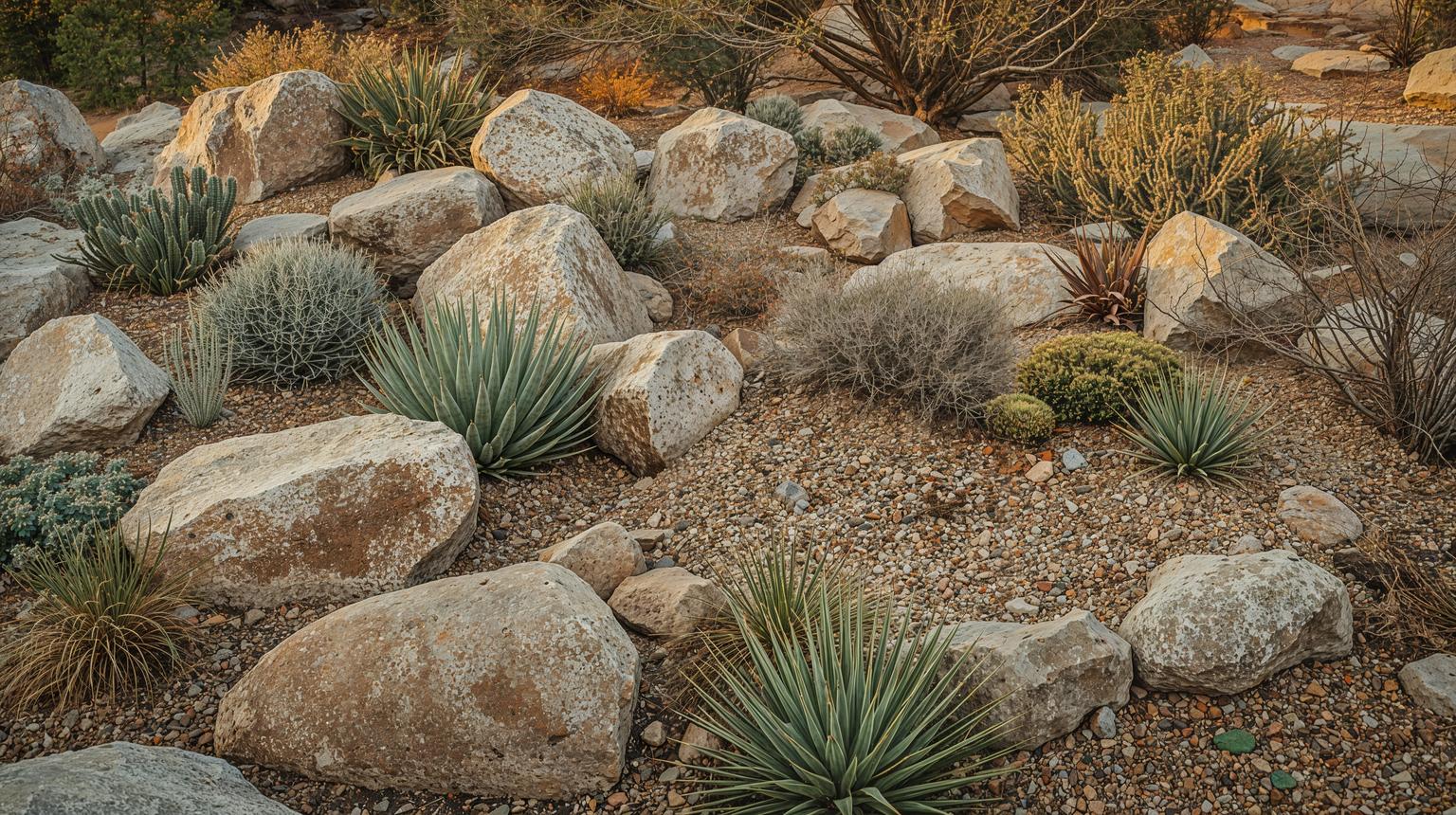
Combine textures and elevation with boulders, river rocks, and other succulents such as echeveria, sedum, and ice plant. Planting flowers in odd clumps and layered elevation gives an organic, curved look. Use this style when landscaping sloped front yards or irregular ground surfaces. Incorporate driftwood or rusted metal accents to accentuate the natural look and solar uplights to highlight focal flowers or rockwork at dusk.
3. Dry Creek Bed for Natural Aesthetics
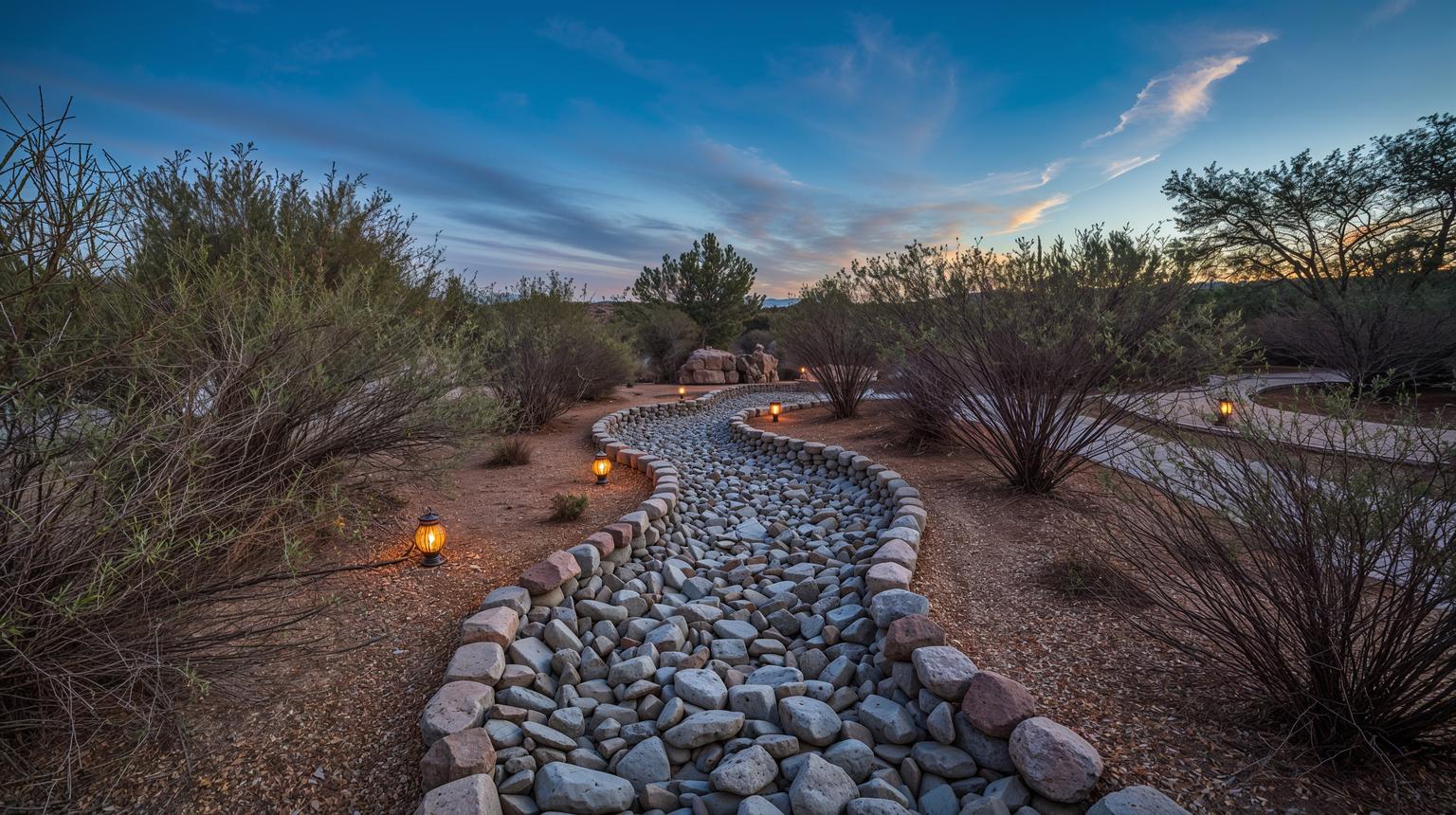
Design desert seasonal creek runs featuring a dry creek bed composed of river stones, gravel, and sand. Incorporate drought-resistant bushes like red yucca or desert spoon to border for texture and contrast. Such a design diverts rainwater as well as results in less erosion without otherwise changing the original look. Low voltage solar lighting on pathways or fine spotlights are sufficient to turn the scenario into a mystical and stunning one come evening and nighttime.
4. Small Front Yard Desert Landscape Ideas
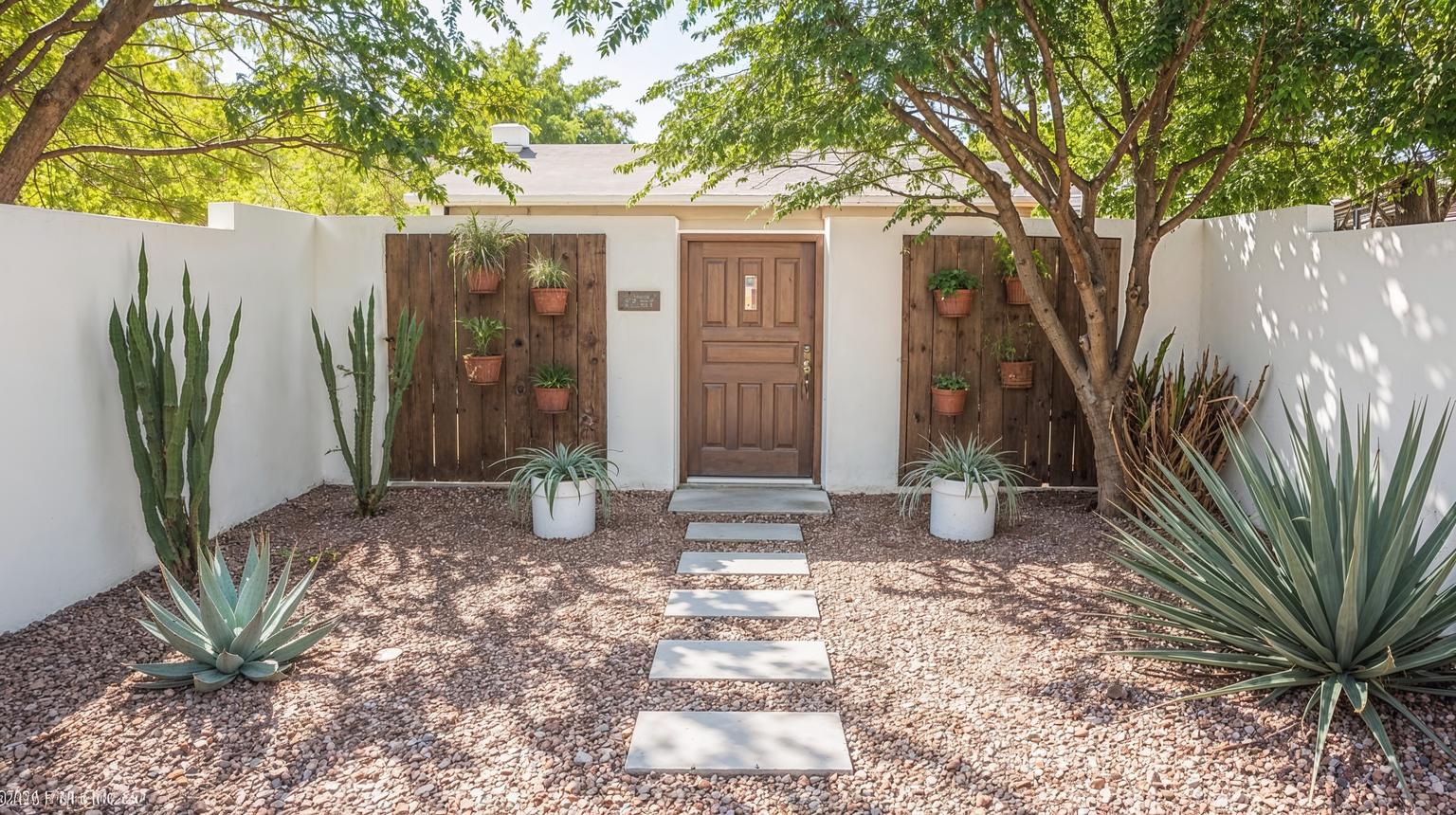
Maximize narrow spaces with vertical gardening techniques, wall-mounted planters, and small succulent container gardens of hens-and-chicks or jade plants. Include slender, winding walks in flagstones or pavers for movement and sense of depth. Light-colored grays or reflective mulch supply brightness, but mirrors or metallic touches will do the trick to make the area appear larger and more visually interesting.
5. Budget-Friendly Desert Landscaping for Front Yards
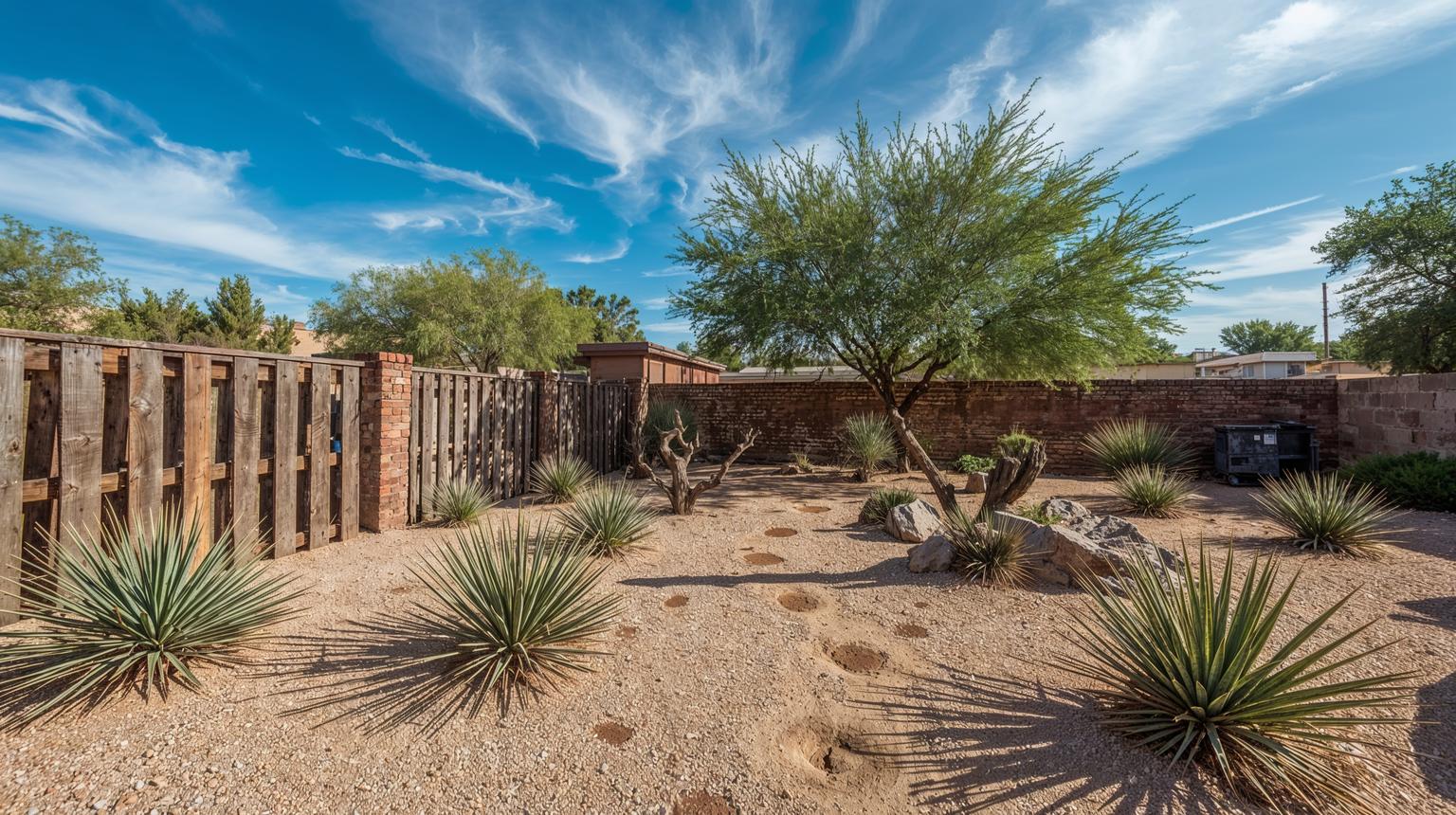
Utilize locally sourced materials such as decomposed granite, crushed gravel, and native plants to maintain affordability and contribute to regional ecosystems. Upcycle used containers, bricks, or wood pallets as chic planters or borders. Add mulch to conserve moisture and prevent weeds. Adding a simple drip system and using solar garden lights can further reduce expenses while maintaining the functionality and beauty of the yard.
6. Desert-Themed Front Yard with Sculptural Elements

Give your front yard personality through the addition of sculptural elements like corten steel sculpture, weathered driftwood, or hand-painted terracotta planters. Position dramatic plants like agave americana or golden barrel cactus in proximity to these elements to border and accentuate them. Balance sharp lines with rounded forms or soft mounding plants like blue fescue. These visually striking additions create interest and reflect your individual style.
7. Palm Trees and Native Grasses for Texture
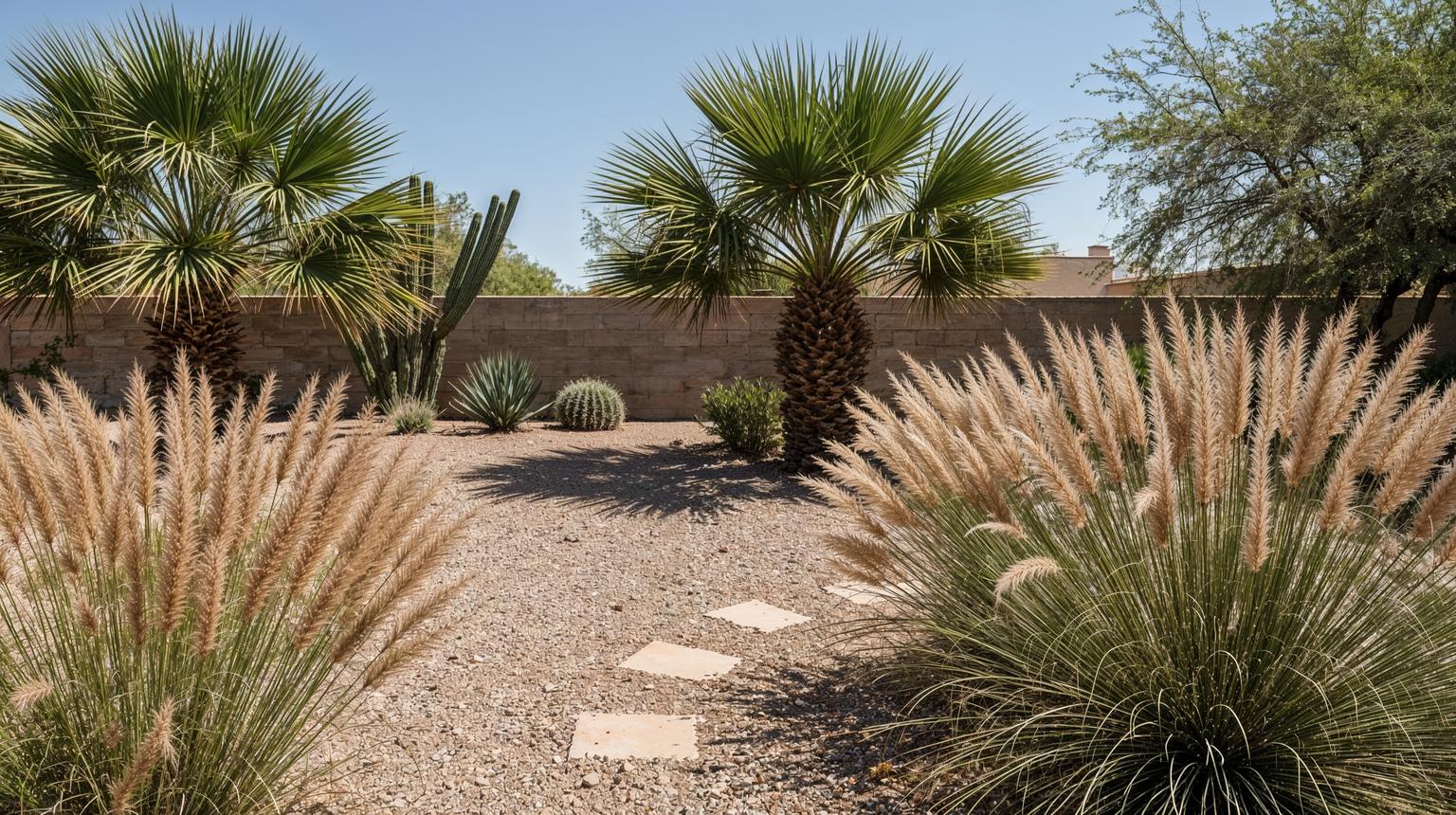
Accomplish textural contrast using erect palms like Mediterranean fan or pygmy date and flowing soft native grasses like pink muhly or deer grass. The flowing softness of the grasses creates contrast to the structural hardness of desert cacti and succulents. Plant grass in clumps for natural edges or to fill in empty spaces. This layered effect provides depth and breaks up harsh lines in hardscaping.
8. Low-Maintenance Desert Landscape with Pathways
Lay winding garden walkways using flagstone, decomposed granite, or recycled concrete to produce a natural but structured appearance. Create boundaries with groupings of low-profile succulents like sedum or ice plant that hugs the ground to enforce visual order and steer foot traffic. These walkways enhance usability at night while reducing erosion and improving drainage. Use solar lights to illuminate the paths for maximum use at night.
9. Incorporate Color with Desert Wildflowers

Add dynamic low-water color with drought-tolerant native desert wildflowers such as desert marigold, firecracker penstemon, and brittlebush. Spring-blooming flowers welcome beneficial insects like bees and butterflies, and provide biodiversity. For lasting impact, mass in waves or drifts rather than as individual plants. Their natural hardiness makes them an ideal choice for front yard desert gardening with little maintenance while bursting with color.
Front Yard Desert Landscaping Ideas on a Budget

One of the least expensive changes you can make is to replace worn-out grass lawns with decomposed granite or gravel. They are inexpensive, easy to install, and reduce water consumption and maintenance needs.
Choosing native and drought-tolerant plants not only saves you money on water but also keeps your landscape looking great with minimal effort. Agave, yucca, and desert marigold are lovely and tough plants.
Mulch use is also another cost-effective idea. Mulch retains moisture, prevents weeds from growing, and enhances the garden's overall appearance. Locally obtained organic mulch or gravel can be used to cut back on expenses.
A drip irrigation system is one that pays in the long run. It gets water right into the roots and saves on unnecessary waste, providing healthy plant development.
Lastly, be fond of DIY endeavors. Having a do-it-yourself rock pile, repurpose materials to decorate edging and planters, and repurpose found items for uniqueness creates that special character at a reduced price and makes your desert front yard absolutely unique.
Essential Elements of a Desert Landscape Front Yard

Desert landscaping is both minimalist in an aesthetic sense and eco-friendly. Central to this are low-water plants like succulents, cacti, yucca, and agave, which are not water-hungry and thrive in heat. Hardscaping is also a staple, using materials like gravel, decomposed granite, and stone pavers to create structure without demanding much upkeep.
A minimalist aesthetic in landscaping has the purpose of reducing clutter, emphasizing clean lines and natural contours, and facilitating easier upkeep. Efficient irrigation systems-especially drip irrigation with timed scheduling-demand to deliver water directly to plant roots and cut down on wastage. Last but not least, an application of mulch or designer gravel spread roughly an inch above plant bases retains moisture in soil, eliminates weeds, and provides an integration between the desert desert front yard components.
Front Yard Desert Landscaping Maintenance Tips
To keep your desert front yard looking its best, it's important to follow a few habits of maintenance particular to dry environments. Start by watering infrequently but deeply. Most desert plants like to dry out between waterings, which encourages deep root development and replicates their natural environment.
Pruning is another crucial step-cut dead or invasive branches regularly to enhance plant health and preferred shape. It also prevents pests from entering and fosters airflow, especially for dense shrubs like lavender or sage.
Mulch, decorative gravel, or organic gravel needs to be replaced or replenished annually. It helps retain soil moisture, suppresses weeds, and keeps roots cool during hot weather. Weeding is also a routine requirement; removing invasive growth early prevents competition for water and nutrients.
Finally, inspect your irrigation system every month to ensure that it's functioning optimally. Drip lines need to be cleaned, and emitters should be positioned in the correct position at plant bases to avoid runoff or evaporation. With minimal upkeep, these practices maintain your desert front yard landscape shining all year round.
How Paintit.ai Can Help You Design a Perfect Desert Front Yard
At Paintit.ai, we combine AI-powered visualization with expert landscaping knowledge to help you achieve your desert front yard vision. From customized plant recommendations to visual previews of your new yard, our website simplifies every step of the design process.
Conclusion
Turning your front yard into a desert oasis is a savvy and trendy choice. If you are looking to create a modern desert front yard or simply looking for simple front yard desert landscape ideas, an effective plan can bring elegance, usability, and sustainability.
Frequently Asked Questions
How can I achieve a desert landscape in my front yard on a limited budget?
Use native vegetation, gravel instead of grass, and recycled items. Avoid complicated installations.
What are the best drought-tolerant plants for a desert front yard?
Succulents, agave, yucca, cacti, and native grasses are ideal.
How do I add color to a desert front yard?
Plant desert wildflowers like penstemon or desert marigold and add colored pottery.
What type of hardscaping elements are ideal for desert landscaping?
Gravel, boulders, dry creek beds, and stone walkways are on the list.
How do I maintain a front yard desert landscape?
Water sparingly, weed, mulch annually, and trim flowers frequently.
What are the best ways to irrigate desert landscaping?
Drip irrigation systems conserve water and are effective.
What are some benefits of planting gravel instead of grass in a front yard?
Gravel saves water, does not require mowing, and is visually appealing.
Can a desert landscape be included in a small front yard?
Yes, incorporate container plants, vertical gardens, and light-colored gravel to maximize space.
What are some fantastic lighting ideas for an elegant desert front yard?
Use solar-powered spotlights, walkway lighting, or sculptural pieces with backlighting.
How do I have a distinctive front yard desert garden?
Include pieces of art, dramatic plant combinations, or custom pathways for individuality.
Trending
Top 6 Homestyler Alternatives: Best Tools for Instant Interior Design
Preppy Bedroom Ideas: How to Master the New Traditionalism
Expert Review of AI Virtual Staging Platforms for Precise Furniture Selection
What Are the Best Spacely AI Alternatives?
The Future of Design 2030: How Agentic AI & Paintit.ai Will Transform Your Home
Related articles

9 min read
Interior Design Trends Winter 2025-2026 & H1 Forecast: The Era of Emotion
Discover the defining interior design trends for Winter 2025/2026. From Moody Palettes and Warm Minimalism to the explosion of Dopamine Decor, explore the forecast with Paintit.ai
Juliy Cherevko
CEO paintit.ai

9 min read
Top 6 Homestyler Alternatives: Best Tools for Instant Interior Design
Searching for Homestyler alternatives? We compare the 5 best tools of 2025. From complex manual modeling to instant AI design with Paintit.ai. Read the review.
Juliy Cherevko
CEO paintit.ai

7 min read
Preppy Bedroom Ideas: How to Master the New Traditionalism
Discover 15 trendy preppy bedroom ideas for 2025. Learn how to mix patterns, choose perfect preppy wall colors, and style iconic furniture
Juliy Cherevko
CEO paintit.ai

16 min read
Expert Review of AI Virtual Staging Platforms for Precise Furniture Selection
Compare AI virtual staging platforms focused on furniture style selection, customization features, pricing, speed, and usability for property design
Juliy Cherevko
CEO paintit.ai

6 min read
What Are the Best Spacely AI Alternatives?
s Spacely AI worth it? Discover the best alternatives for architects and agents. Detailed review of Paintit.ai, RoomGPT, and others
Juliy Cherevko
CEO paintit.ai

5 min read
The Future of Design 2030: How Agentic AI & Paintit.ai Will Transform Your Home
Tired of managing renovations? By 2030, Agentic AI will do it for you. Explore Paintit.ai’s vision for autonomous design and the Agent-to-Agent economy
Juliy Cherevko
CEO paintit.ai

